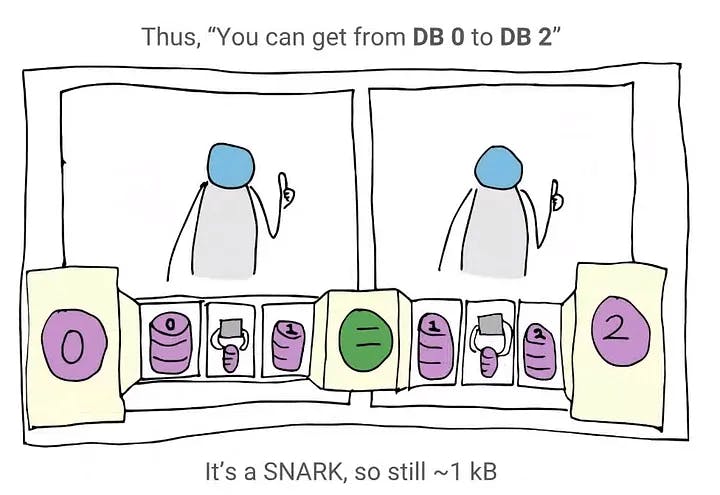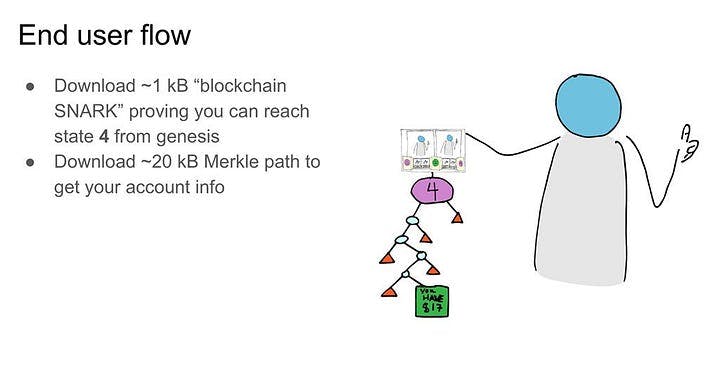Introduction
The Mina Protocol, also known as Mina, is a lightweight blockchain protocol designed to address the scalability and decentralization challenges that exist in traditional blockchain networks. It aims to create a highly efficient and accessible platform for decentralized applications (dApps) and digital currencies.
At its core, Mina achieves its lightweight nature by utilizing a revolutionary concept called "zk-SNARKs" (Zero-Knowledge Succinct Non-Interactive Arguments of Knowledge). zk-SNARKs allow Mina to maintain a small, constant-sized blockchain that is around 22 kilobytes, regardless of the number of transactions or smart contracts executed on the network. This enables fast and scalable transaction processing, reducing storage requirements and improving overall network performance.
By leveraging zk-SNARKs, Mina achieves a remarkable feat: it can validate the entire blockchain's history by verifying cryptographic proof that attests to the validity of each transaction without storing the full transaction history itself. This means that any participant in the network can fully verify the blockchain's integrity without needing to store and process the entire blockchain's data.
The decentralized nature of Mina is facilitated by a consensus mechanism called "Proof of Stake" (PoS), where participants (known as stakeholders) can lock up their Mina tokens as collateral to create new blocks and validate transactions. This design ensures that the network remains secure while providing incentives for stakeholders to actively participate in the protocol's governance.
Mina also emphasizes privacy, as transactions are shielded by zk-SNARKs, enabling users to protect their financial information. Furthermore, Mina supports the development and execution of smart contracts, allowing developers to create decentralized applications on the protocol.
The Mina Protocol is governed by the Mina Foundation, a non-profit organization dedicated to advancing the protocol's development and adoption. The foundation works closely with the community and stakeholders to ensure the protocol's integrity, security, and long-term sustainability.
Overall, Mina Protocol's combination of lightweight design, scalability, privacy features, and decentralized governance makes it an intriguing solution for building decentralized applications and powering digital currencies in a more efficient and accessible manner.
How Mina Works
Mina Protocol utilizes zk-SNARKs (zero-knowledge succinct non-interactive arguments of knowledge) as a core component of its design to ensure the integrity and security of the blockchain while minimizing the amount of data that needs to be stored and transmitted.
zk-SNARKs enable Mina to create unforgeable certificates that prove the correctness of a computation without revealing the underlying details of that computation. In the context of Mina, this means that instead of validating and proving the entire transaction history of a block, a single SNARK (~1kB in size) can be used to verify the accuracy of the block's transaction history.
The SNARK encapsulates the validation of various aspects, including:
Transaction Signatures: The SNARK verifies that the transactions included in the block are correctly signed, ensuring that they come from the appropriate senders and are authorized.
Transaction Validity: The SNARK confirms the validity of the transactions, checking if they adhere to the protocol's rules and constraints. This ensures that transactions meet specific criteria, such as having valid inputs and outputs, following the transaction format, and obeying any other rules defined by the protocol.
Consensus Rules: The SNARK enforces the consensus rules of the network. For proof-of-work (PoW) blockchains, this includes verifying the total hash power and the strength of the chain. In the case of proof-of-stake (PoS) blockchains, the SNARK ensures compliance with rules related to the Variable Random Function (VRF) and other relevant consensus protocols.
It's important to note that if a SNARK is not honestly generated or if any aspect of the computation is incorrect, it will be detected and deemed invalid by any participant on the network. This means that even lightweight devices like a Raspberry Pi or smartphone can easily verify the validity of a SNARK, contributing to the network's security and integrity.
By utilizing zk-SNARKs, Mina Protocol achieves efficient and trustless validation of transactions and ensures that the entire transaction history does not need to be stored or transmitted. This approach significantly reduces the computational requirements for network participants and promotes a lightweight blockchain that remains accessible and secure, even as the network scales and accumulates more transaction data.

In order to address the linear growth issue caused by simply replacing each block with a SNARK in the Mina Protocol, a recursive composition of SNARKs is employed.
Rather than creating a SNARK for each individual block, Mina utilizes a technique where multiple certificates or SNARKs are combined into a single certificate or SNARK. This recursive composition allows the blockchain to maintain a constant size of approximately 20kB, which includes the SNARK itself and the tail-end Merkle path.
With each new block produced, a new SNARK or certificate is generated. Instead of independently verifying each SNARK, a single "mega" SNARK is created by combining the previous certificates. This mega SNARK represents the entire transaction history of the blockchain, enabling users to jump from the genesis block to the current state while remaining the size of a single certificate.

To illustrate this concept, consider a scenario where you have individual certificates stating you can go from Block 0 to Block 2 and from Block 2 to Block 4. These individual SNARKs can be combined into a single SNARK that certifies the ability to go from Block 0 to Block 4.

The new SNARK or certificate remains around 1kB in size. Scaling up, a certificate for the entire transaction history of the blockchain can be created, while still maintaining a constant size, regardless of the number of certificates included in the most recent SNARK.
A validating node in the Mina Protocol will comprise a recursively composed zk-SNARK (~1kB) that proves the validity of the entire past history of the blockchain, along with the Merkle root path of the current state (20kB). These components collectively verify the validity of a user's balance. The synchronization process to verify this information takes only milliseconds, allowing nodes to quickly and efficiently sync up with the network.

By employing recursive composition of SNARKs, Mina achieves a scalable and efficient solution that addresses the issue of linear growth, enabling a lightweight and accessible blockchain while maintaining the security and integrity of the transaction history.
Top 3 features of Mina Protocol
Mina Protocol achieves true decentralization, scale, and security through its innovative use of zk-SNARKs and the modified Ouroboros proof-of-stake protocol.
Decentralization: Mina Protocol aims to maintain a decentralized structure where power remains in the hands of the many. Traditional blockchains require new participants to download and verify the entire transaction history, which can be computationally expensive and impractical. Mina solves this problem by replacing the blockchain with a small cryptographic proof. Participants use zk-SNARKs, which are recursive zero-knowledge proofs, to validate the network and transactions. This approach reduces the data requirements for each user, making it accessible for more individuals to participate in the network as full nodes. By enabling anyone to validate the network, Mina ensures decentralization and prevents reliance on powerful intermediaries.
Scalability: Legacy blockchains face scalability challenges as their transaction histories grow, leading to increased storage and computational requirements. Mina addresses this issue by using zk-SNARKs to capture the state of the entire blockchain as a lightweight snapshot. This snapshot is sent across the network, significantly reducing the amount of data participants need to download and store. As the network continues to grow and accumulate transaction data, the size of the snapshot remains consistent. This approach allows Mina to scale to many users and years of transaction history while maintaining accessibility.
Security: Mina Protocol leverages the modified Ouroboros proof-of-stake protocol to achieve security in consensus. In this protocol, all participants act as full nodes and can take part in consensus, ensuring that the network is secured by a diverse set of stakeholders. By utilizing proof-of-stake, Mina incentivizes participants to lock up their Mina tokens as collateral to create new blocks and validate transactions. This design enhances the security of the network and ensures that participants have a stake in maintaining the protocol's integrity.
Role of Node operators
In the Mina Protocol, node operators play a crucial role in maintaining the network and ensuring its proper functioning. As a node operator, an individual or entity runs a full node on the Mina network, contributing to the validation of transactions and the overall security of the protocol. Here are some key aspects related to node operators in the Mina Protocol:
Full Node Operation: Node operators run full nodes, which involve maintaining a complete copy of the blockchain and participating in the consensus process. Full nodes verify transactions, validate blocks, and store the necessary data to ensure the integrity and correctness of the blockchain.
Block Production: Node operators have the opportunity to produce blocks in the Mina network. This process involves creating new blocks that contain validated transactions and adding them to the blockchain. Block production is determined through the modified Ouroboros proof-of-stake protocol, where node operators with Mina tokens staked as collateral have a chance to be selected as block producers.
Transaction Validation: Node operators are responsible for validating transactions in the Mina network. This includes verifying the authenticity of transactions, ensuring that they adhere to the protocol's rules, and confirming that they are included in valid blocks.
Consensus Participation: Node operators actively participate in the consensus mechanism of the Mina Protocol. Through the modified Ouroboros proof-of-stake protocol, they contribute to the agreement on the next valid block, reaching consensus with other nodes in the network. Consensus is achieved through a combination of staked Mina tokens, which serve as a measure of a node operator's influence in the protocol.
Network Maintenance: Node operators help maintain the health and stability of the Mina network. They monitor their nodes, perform necessary updates, and ensure that their infrastructure is reliable and available. By running well-maintained nodes, they contribute to the overall resilience and efficiency of the network.
Governance Participation: Node operators may also have the opportunity to participate in the governance of the Mina Protocol. The protocol's governance mechanisms allow stakeholders to propose and vote on changes or improvements to the protocol, enabling active involvement in shaping its future direction.
It's important to note that the specific technical requirements and responsibilities of node operators in the Mina Protocol may evolve over time as the protocol progresses and new features are introduced. However, their fundamental role in maintaining the network, validating transactions, and participating in consensus remains essential to the decentralized and secure operation of the Mina Protocol
In order to become a Node operator one can use https://docs.minaprotocol.com/
Conclusion
In conclusion, Mina Protocol offers a groundbreaking solution to the challenges faced by traditional blockchain networks. By leveraging zk-SNARKs and recursive composition, Mina achieves a lightweight, scalable, and decentralized blockchain infrastructure.
Mina's use of zk-SNARKs allows for the creation of succinct proofs that verify the accuracy of transactions and adherence to consensus rules. These proofs significantly reduce the amount of data that participants need to store and transmit, making it accessible to a wide range of devices and users. The protocol ensures that participants can verify the blockchain's integrity without relying on powerful intermediaries, promoting decentralization and trustlessness.
Through recursive composition, Mina further addresses the issue of linear growth by combining multiple SNARKs into a single certificate. This approach allows the blockchain to remain a constant size over time, regardless of the number of certificates included. It provides a scalable solution for maintaining a compact transaction history while ensuring security and efficient synchronization.
Mina's inclusive consensus, powered by the modified Ouroboros proof-of-stake protocol, allows all participants to act as full nodes, securing the blockchain and holding it accountable. This approach maximizes inclusivity and empowers individuals to participate in consensus, further enhancing the decentralized nature of the network.
